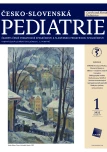Laboratory newborn screening
Authors:
Honzík Tomáš 1; Kožich Viktor 1; Pešková Karolína 1; Votava Felix 2
Authors‘ workplace:
Klinika pediatrie a dědičných poruch metabolismu 1. LF UK a VFN, Praha
1; Klinika dětí a dorostu 3. LF UK a FN Královské Vinohrady, Praha
2
Published in:
Čes-slov Pediat 2022; 77 (1): 12-18.
Category:
Chapters for Specialization in Pediatrics
Overview
Introduction: laboratory newborn screening (LNS) is a preventive population-wide program that enables early diagnosis and efficient treatment of patients with selected congenital and hereditary diseases and improves significantly their quality of life.
Methodology: analysis of capillary blood collected between 48 and 72 hours of life in the form of a dried blood spot by tandem mass spectrometry, fluorimetry, immunoassay and molecular genetic methods.
Results: in the Czech Republic, LNS was started in 1975 with a search for phenylketonuria (PKU), further expanded in 1985 by congenital hypothyroidism (CH), in 2006 by congenital adrenal hyperplasia (CAH), in 2009 by cystic fibrosis (CF) and 9 other inborn metabolic diseases. The number of diseases was further expanded in 2016. In 2010-2020, a total of 1,100 patients with one of the target diseases were diagnosed with LNS by analysing more than 1.2 million newborns. The cumulative neonatal prevalence of all 18 diseases is 1 : 1,100. The most common diseases are CH, PKU, CF and partial biotinidase deficiency. From 2022, the start of a pilot program for further LNS expansion by adding spinal muscular atrophy and severe combined immunodeficiencies is planned.
Conclusion: advances in technology and treatment enable expansion of LNS programs worldwide in compliance with the still valid WHO criteria according to Wilson and Jungner.
Keywords:
Cystic fibrosis – congenital adrenal hyperplasia – laboratory newborn screening – congenital hypothyroidism – inborn metabolic diseases
Sources
1. Guthrie R, Susi A. A simple phenylalanine method for detecting phenylketonuria in large populations of newborn infants. Pediatrics 1963; 32 : 338–343.
2. Wilson JMC, Junger G. Principles and practise of screening for disease. Public Health Papers 1968; 34, Geneva World Health Organization.
3. Metodický návod k zajištění celoplošného novorozeneckého laboratorního screeningu a následné péče. Věstník Ministerstva zdravotnictví ČR, 2016; 6 : 2–12.
4. Franková V, Dohnalová A, Pešková K, et al. Factors influencing parental awareness about newborn screening. Int J Neonatal Screen 2019; 5(3): 35. doi: 10.3390/ijns5030035
5. McCandless SE, Wright EJ. Mandatory newborn screening in the United States: History, current status, and existential challenges. Birth Defects Res 2020; 112(4): 350–366.
6. Loeber JG, Platis D, Zetterström RH, et al. Neonatal Screening in Europe Revisited: An ISNS Perspective on the Current State and Developments Since 2010. Int J Neonatal Screen 2021; 7(1): 15. doi: 10.3390/ijns7010015
7. Tangeraas T, Sæves I, Klingenberg C, et al. Performance of expanded newborn screening in Norway supported by post-analytical bioinformatics tools and rapid second-tier DNA analyses. Int J Neonatal Screen 2020; 6(3): 51. doi: 10.3390/ijns6030051
8. Mohamed AE, van den Heuvel L. Editorial: Newborn screening for inborn errors of metabolism: Is it time for a globalized perspective based on genetic screening? Front Genet 2021; 12 : 758142. doi: 10.3389/fgene.2021.758142
Labels
Neonatology Paediatrics General practitioner for children and adolescentsArticle was published in
Czech-Slovak Pediatrics

2022 Issue 1
Most read in this issue
- Laboratory newborn screening
- Differential diagnosis in paediatric inflammatory multisystem syndrome temporally associated with SARS-CoV-2
- Brief overview of child and adolescent psychopharmacotherapy
- Z historie pediatrie
